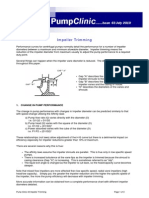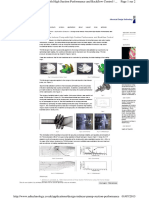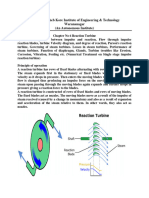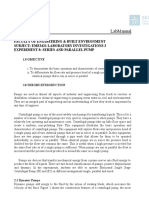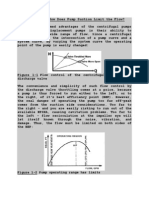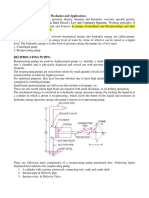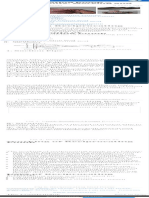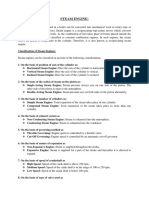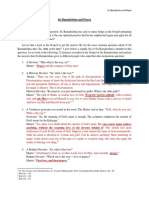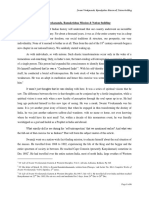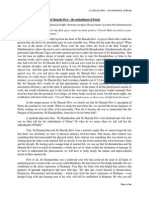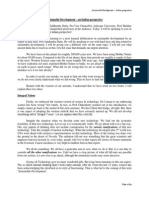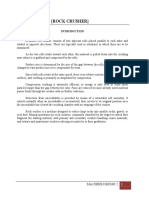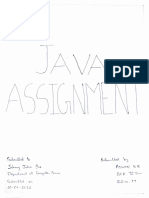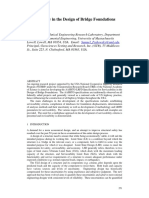A Course On Reciprocating Pump
A Course On Reciprocating Pump
Uploaded by
Swami VedatitanandaCopyright:
Available Formats
A Course On Reciprocating Pump
A Course On Reciprocating Pump
Uploaded by
Swami VedatitanandaOriginal Description:
Original Title
Copyright
Available Formats
Share this document
Did you find this document useful?
Is this content inappropriate?
Copyright:
Available Formats
A Course On Reciprocating Pump
A Course On Reciprocating Pump
Uploaded by
Swami VedatitanandaCopyright:
Available Formats
III year Mech-Recip Pump
A Course on Reciprocating Pump Mech Diploma III year Introduction: Turbo machines are mechanical devices that either extract energy from a fluid (turbine) or add energy to a fluid (pump) as a result of dynamic interactions between the device and the fluid. There are two main types of pumps namely Dynamic pumps and Positive displacement pumps. Dynamic pumps consist of centrifugal, axial and mixed flow pumps. In these cases pressure is developed by the dynamic action of the impeller on the fluid. Momentum is imparted to the fluid by dynamic action. Positive displacement pumps consist of reciprocating and rotary types. These types of pumps are discussed in this course. In these types a certain volume of fluid is taken in an enclosed volume and then it is forced out against pressure to the required application. Classification of Positive Displacement Pumps: Type and construction features of reciprocating pump: 1. Position: Vertical, Horizontal 2. Purpose: Metering Pump, Power Pump 3. Piston or Plunger acting : Single acting, Double acting 4. Number of Plunger in One Casing : Single, Duplex, Triplex, Multiplex 5. Liquid End Type : Direct exposed, Diaphragm 6. Plunger direction: Forward, Backward. Generally, there are the following types of Positive Displacement Pumps: Rotary Lobe Pump, Rotary Gear Pump, Screw Pump, Vane Pump, Regenerative Pump, Peristaltic Pump, Diaphragm Pump, Progressive Cavity Pump, etc. Reciprocating pumps can be single acting, double acting, etc. a) Single acting Recip Pump consists of one suction and one delivery pipe simply connected to one cylinder. b) Double acting single cylinder Recip pump has two suction and two delivery pipes connected to one cylinder. c) Two-throw Recip pump has two cylinders each equipped with one suction and one delivery pipe. The pistons reciprocating in the cylinders are moved with the help of connecting rods fitted with a crank at 180o. d) Three-throw Recip pump has three cylinders and three pistons working with three connecting rods fitted with a crank at 120o
Page 1 of 11
III year Mech-Recip Pump
We will study Single-acting Recip pump & Double acting Recip Pump in some detail. Single-acting Recip Pump Description of a Single-acting Recip Pump: Main components: The main components are: 1. Single Cylinder with suitable valves at inlet and delivery. 2. Plunger or piston with piston rings. 3. Connecting rod and crank mechanism. 4. Suction pipe with one-way valve. 5. Delivery pipe with one-way valve. 6. Supporting frame. A diagrammatic sketch is shown in Fig. 20.1
Working description: A reciprocating pump has a piston which gets its motion by means of a Crank shaft Connecting Rod arrangement. Therefore it is called Reciprocating Pump. Liquid is sucked into the cylinder and then ejected out by the motion of the piston and hence it is called Positive Displacement Pump. If delivery occurs only during the delivery stroke of the piston, then such a reciprocation pump is called Single-acting Pump. Mechanical rotary motion is obtained from a motor to which a crank-rod is attached. Rotary motion is translated into reciprocatory motion using a connecting-rod and piston arrangement as shown. The piston is placed inside a sealed cylinder that has an inlet and outlet. A suction pipe is connected to the inlet of the pump and delivery pipe is connected to outlet of
Page 2 of 11
III year Mech-Recip Pump
the pump. The inlet and outlet of the pump are covered by a one-way non-return valve which allows flow of liquid along only one direction. The pump functions in two distinct stages: 1. Suction phase: : When , the piston is at the inner dead center [IDC]. As the piston moves away from the IDC, pressure inside the cylinder drops and the oneway suction valve opens. This happens because the liquid is incompressible. Liquid rushes in through the suction pipe into the cylinder.When , the piston is at the outer dead center [ODC]. The cylinder is completely filled with the liquid. 2. Delivery phase: : When the piston starts moving away from ODC towards the IDC. Pressure builds up inside the cylinder. Immediately, the one-way delivery valve opens and the suction valve closes. Liquid is pushed out of the cylinder. At the entire liquid inside the cylinder has been emptied and the cycle gets repeated. Naturally, the delivery occurs only during one half of the crank-shafts rotation and in the other half there will be no delivery. Thus, a single-acting Recip pump gives a fluctuating delivery of liquid. Pump characteristics: 1. Delivery: [Qact] Suppose the length of the cylinder is assumed to be equal to the sweep of the piston, which is again equal to the diameter of the circle made by the crank-shaft rotation. Let the length of the crank-shaft be L meters. Let the cross-sectional diameter of the cylinder be D meters. We know that the delivery of liquid in one revolution is volume of liquid in the cylinder. Again, the delivery of liquid in m3/s is: ( ) ( ). Let the pump make N revolutions per minute. Then, ( )( )( ) m3/s 2. Slip:There can be leakage along the valves, piston rings, gland and packing which will reducethe discharge to some extent. This reduction in the actual discharge is accounted for by using the term Slip.
3. Coefficient of Discharge: Cd is an important Pump characteristic. It is defined as the ratio of actual discharge of a pump to its theoretical discharge.
4. Percentage Slip: is another common Pump characteristic that is used to define a Recip pump. It is calculated as follows: [ ]
Page 3 of 11
III year Mech-Recip Pump
( ( )
It is generally seen that Slip is a positive quantity in most cases. In other words, the actual discharge is lesser than theoretical discharge in most cases. However, it has been found in some cases that , due to operating conditions. In this casethe slip is called Negative Slip. Reason for negative slip: When the delivery pipe is short or the delivery head is smalland the accelerating head in the suction side is high, the delivery valve is found to open before the end of suction stroke and the liquid passes directly into the delivery pipe. Such a situationleads to negative slip. 5. Power required to run the pump: We know that: If the pump raises the liquid from a height hs and delivers it to a height hd, then ( )watts. Indicator Diagram The pressure variation in the cylinder during a cycle consisting of one revolution of the crank, when represented in a diagram is termed as indicator diagram. The same is shown in figure below:
It must always be noted that indicator diagram is only indicative of the actual piston positions and pressures inside the cylinder and not a true graphical representation. Let us suppose that: Point 1 represents position of the piston at its IDC or cycle.
. This is the start of the suction
Page 4 of 11
III year Mech-Recip Pump
Point 2 represents position of the piston at its ODC or . This is the end of the suction cycle. Point 3 represents position of the piston again at its ODC or . This is the start of the delivery cycle. Point 4 represents position of the piston again at its IDC or . This is the end of the suction cycle. The quadrilateral 1234 thus represents the total work done by the pump in one cycle of the crank-shaft. The suction pressure-head, delivery pressure-head and atmospheric pressurehead are also represented in the figure. This is the Indicator Diagram for an ideal cycle. In an ideal cycle, we consider that only suction pressure-head and delivery pressure-head are present in the two cycles and no other pressure-heads are present inside the cylinder. In reality, however, many other components of pressure-heads come into play inside the cylinder in a cycle. Some of them are acceleration pressure-head and friction pressure-head. We shall consider the effect of acceleration pressure-head on the working of a single-acting Recip pump and on its Indicator Diagram. Effect of acceleration pressure-head:
When to , the piston creates a suction pressure inside the cylinder. So the liquid rushes into the cylinder from the suction pipe. The piston however is moving and hence has acceleration from The piston has deceleration from The fast moving liquid also has acceleration and deceleration corresponding to that of the piston. This acceleration of the liquid generates a pressure component. This is denoted as during the suction phase and as during the delivery phase. When we include this component of pressure-head due to acceleration of liquid, the Indicator Diagram gets modified as shown above.
Page 5 of 11
III year Mech-Recip Pump
At , the pressure-head due to acceleration of liquid gets added on to the suction pressurehead and hence Point 1 gets shifted to Point 1`. At , since the acceleration is 0, the only pressure-head present inside the cylinder is the suction pressure-head. At , the pressure-head due to deceleration reduces the suction pressure-head. Hence, Point 2 gets shifted to Point 2` as shown. Similarly, at , at the beginning of the delivery stroke, the pressure-head due to acceleration of liquid gets added to the delivery pressure-head. Hence Point 3 gets shifted to Point 3`. And at , at the end of the delivery stroke, the pressure-head due to deceleration of liquid reduces the delivery pressure-head inside the cylinder. Hence the Point 4 gets shifted to Point 4` as shown in figure. To derive an expression for variation of pressure inside a cylinder: Consider the following figure:
We assume that the ratio of Connecting Rod to Crank-shaft is very large. Then we can assume that the piston has simple harmonic motion. Let us therefore assume that as the Crank moves through a radial distance of in time t seconds, the piston moves a linear distance of x meters. Let us further assume the following: .
Page 6 of 11
III year Mech-Recip Pump
The distance x travelled by the piston is given by:
Now, by differentiating this equation on time, we get the velocity of the piston. ) So, ( . From Continuity equation, we know that the volume of liquid flowing into the cylinder per second is equal to volume of water flowing through the suction pipe per second.
Or,
Or, ) ( From this, we can get an expression for acceleration of liquid in suction pipe by differentiating above relation against time: ( ( )) . What we need to derive here is the pressure-head due to acceleration of the liquid in the suction pipe or in the cylinder. ( ) ( ) Now, And ( ) ( )
Again, from Newtons Laws, we know that: ( )( ( ( )( ( )(
)( )(
) )( )
) ) for various points in the cycle as follows:
From this expression, we can specify Suction phase: Beginning of suction phase: ( ) ( )( ); since
Page 7 of 11
III year Mech-Recip Pump
Middle of suction phase: ; since End of suction phase: ( ) ( )( ); since We can similarly derive expressions for the delivery phase too. However, we will have to consider again instead of , for in the latter case, the expressions we derive will not match with reality! Delivery phase: Beginning of delivery phase: ( ) ( )( ); since Middle of delivery phase: ; since End of delivery phase: ( )(
)(
); since
Separation: When the pressure reduces inside the cylinder or in some part of the suction pipe or delivery pipe, in some cases, it may so happen that the absolute pressure-head1 may drop below the Vapor Pressure-head2 of the liquid. Under that condition, the liquid inside the hydraulic system undergoes a phase change and becomes a gas. The phenomenon is exactly like boiling. The phase change occurs by formation of gas bubbles. When this happens, output drops and further cavitation3 may occur. This has to be avoided in a Recip pump. This phenomenon is called Separation. Therefore with reference to a Recip pump, the vapor pressure -head of the liquid used is also called as Separation pressure-head [ ]. As we saw above, the Delivery [Qact] of a Recip pump is a function of its speed. So, in order to increase output, we have to increase its speed. However, the absolute pressure-head inside the cylinder and pipes is a function of Qact. In our attempt to increase output of a Recip pump, if we increase its speed to such a level that separation occurs, then our purpose is not served. So is a limiting condition for increasing the speed of a Recip pump.
1Absolute Pressure-head: pressure-head in each case. Thus we have: Suction stroke: Beginning: End: ( Delivery stroke: Beginging: End: ( ; Take care to incorporate the appropriate sign for the ( ) ( ) ) )
2Vapor Pressure: A liquid will change phase and become a gas under two conditions. If its temperature goes higher than its boiling temperature; or if its absolute pressure -head dips below its vapor pressure-head. 3Cavitation: When a liquid enters a region of pressure equal to or below its vapor pressure, the liquid changes its phase. When this happens in a hydraulic system, it is called Separation. Generally gas bubbles are formed, which later on collapse on the inner wall of the hydraulic system. When a bubble collapses, localized high pressure center is created. This high pressure removes material from the wall. The process of loss of material is called Pitting. The entire process of low pressure, separation, gas bubbles and pitting is called Cavitation.
Page 8 of 11
III year Mech-Recip Pump
Use of Air-vessels: We have now seen two problems we face when we use a Recip pump. The first one is that there is constant pressure variation inside the pump during a cycle. The second one is that we cannot increase its speed beyond a certain limit. These two problems can be solved to some extent by use of Air-vessels at appropriate places in the hydraulic system.
Air vessel is a closed chamber containing compressed air in the top portion and liquid at the bottom portion, as shown in the figure. Air vessels are fitted on the suction and delivery pipes, as close to the pump as possible. We have already seen from the modified Indicator Diagram how pressure-head varies inside the cylinder during the suction stroke. This pressure-head variation naturally affects the behavior of liquid inside the suction pipe since the liquid is a continuum; similarly on the delivery stroke. This pressure-head variation affects the discharge, making it uneven. Using Air vessels on the suction & delivery pipes can reduce this fluctuation to a certain extent. During the different points in the delivery stroke, the pressure-head components inside the pump system are tabulated as shown below: Piston position Pressure-head components ( ) Suction stroke: Beginning Suction stroke: Middle ( ) Suction stroke: End ( ) Delivery stroke: Beginning Delivery stroke: Middle ( ) Delivery stroke: End
Page 9 of 11
III year Mech-Recip Pump
For easy understanding, we shall consider the delivery phase: We find that the component is creating the pressure fluctuation in the delivery stroke. If this component can be eliminated, then we will have a uniform pressure-head of throughout the stroke. So, we can add an Air Vessel near the place where the delivery pipe joins the Recip pump. When a suitable Air Vessel is added, at the beginning of the delivery stroke, when the discharge increases due to the effect of component, this extra discharge enters into the Air Vessel. Only that discharge that is due to enters into the delivery pipe. At the end of the stroke, ( ) component reduces the discharge, and then the extra liquid from the Air Vessel is supplied into the delivery pipe. As a result, the output from the pump remains a constant equal to the pressure-head of . Placing of the Air Vessel has to be as near to the junction of the pump and delivery pipe so that the effect of is localized to as small a region as possible. Similarly, the Air Vessel stabilizes the input into the pump during the suction stroke. Therefore using an appropriate Air Vessel maintains a mean discharge from the pump. Double-acting Recip pump: Description Main components: The main components are: 1. Single Cylinder with suitable valves at inlet and delivery on both sides of piston. 2. Plunger or piston with piston rings. 3. Connecting rod and crank mechanism. 4. Suction pipes with one-way valves. 5. Delivery pipes with one-way valves. 6. Supporting frame. A diagrammatic sketch is shown in Fig. 20.2
Page 10 of 11
III year Mech-Recip Pump
Working description: A double-acting reciprocating pump has a piston which gets its motion by means of a Crank shaft Connecting Rod arrangement. Therefore it is called Reciprocating Pump. Liquid is sucked into the cylinder and then ejected out by the motion of the piston and hence it is called Positive Displacement Pump. Since delivery occurs during both the strokes of the piston, such a reciprocating pump is called Double-acting Pump. The pump functions in the following way: 1. : When , the piston is at the inner dead center [IDC]. As the piston moves away from the IDC, pressure inside the cylinder drops and the one-way suction valve on the left-side of the piston opens. This happens because the liquid is incompressible. Liquid rushes in through the suction pipe into the cylinder. But at the same time, pressure builds up on the right-side of the piston and liquid is discharged out of the cylinder. When , the piston is at the outer dead center [ODC]. The discharge on the right-side is completed while the left-side is filled with liquid. 2. : The same process as described above gets repeated in a mirror way and the cycle gets repeated. Naturally, the delivery occurs during both halves of the crank-shafts rotation. Thus, a double-acting Recip pump gives a steady delivery of liquid. Pump characteristics: 1. Delivery: [Qact] Suppose the length of the cylinder is assumed to be equal to the sweep of the piston, which is again equal to the diameter of the circle made by the crank-shaft rotation. Let the length of the crank-shaft be L meters. Let the cross-sectional diameter of the cylinder be D meters. We know that the delivery of liquid in one revolution is twice the volume of liquid in the cylinder. Again, the delivery of liquid in m3/s is: ( ) ( ). Let the pump make N revolutions per minute. Then, ( )( )( )( ) 3 m /s Thus, for a double-acting Recip pump is twice the for a single-acting Recip pump. Once this is calculated, the rest of the pump characteristics can be calculated as before. Note: Only one pump characteristic i.e. is twice of that for a single-acting pump. If you have to determine any other pump characteristic for a double-acting pump, you cannot calculate for a single-acting pump and double it! You will have to obtain the and then calculate using it. *****************
Page 11 of 11
You might also like
- Study of The Centrifugal Pump Efficiency at Throttling and Speed ControlDocument4 pagesStudy of The Centrifugal Pump Efficiency at Throttling and Speed ControlHassan SouleymanNo ratings yet
- Pumps and Seals PDFDocument1,024 pagesPumps and Seals PDFBung TromixNo ratings yet
- Pump KnowledgeDocument17 pagesPump Knowledgesmupy_122100% (1)
- The Source of Hydraulic PowerDocument16 pagesThe Source of Hydraulic Powersekar507100% (1)
- Kks 2Document157 pagesKks 2Aldiarso UtomoNo ratings yet
- 12V2000 PDFDocument103 pages12V2000 PDFczarate1974100% (1)
- Introduction of Various PumpDocument25 pagesIntroduction of Various PumpSajib Chandra RoyNo ratings yet
- Flow Profile For Reciprocating Pumps - Chemical Engineering ProcessingDocument3 pagesFlow Profile For Reciprocating Pumps - Chemical Engineering ProcessingVILLANUEVA_DANIEL2064No ratings yet
- Reciprocating PumpDocument20 pagesReciprocating PumpfarahelNo ratings yet
- Ku Reprint Ps April2007Document2 pagesKu Reprint Ps April2007keyur1109No ratings yet
- Fluid Mechanics Laboratory: Laboratory 06.2: Gear Pump Test RigDocument5 pagesFluid Mechanics Laboratory: Laboratory 06.2: Gear Pump Test RigRitu GavasaneNo ratings yet
- 2011-03 Selection of PumpsDocument47 pages2011-03 Selection of PumpsKwabena OtchereNo ratings yet
- Hydraulic Resevoir Design Criteria PDFDocument10 pagesHydraulic Resevoir Design Criteria PDF2345421No ratings yet
- CFD Analysis and Design ImpellerDocument8 pagesCFD Analysis and Design ImpellerFarooqNo ratings yet
- Mechanical Equipment: Nuclear Training Course 23001 (NEIT 230.1)Document59 pagesMechanical Equipment: Nuclear Training Course 23001 (NEIT 230.1)abuhurairaqazi100% (2)
- Pump Clinic 43Document3 pagesPump Clinic 43fnahas_bhNo ratings yet
- Design of Radial Flow Pump UPDATEDDocument74 pagesDesign of Radial Flow Pump UPDATEDrahuldbajaj2011100% (1)
- Centrifugal Pump Infographics: Gland Packing Mechanical Seal Sealless PumpDocument1 pageCentrifugal Pump Infographics: Gland Packing Mechanical Seal Sealless PumpKIESSENo ratings yet
- Turbo MachineryDocument182 pagesTurbo MachineryAnkit GandhiNo ratings yet
- L .2 Hydraulic PumpDocument45 pagesL .2 Hydraulic PumpMentsnot GetuNo ratings yet
- BB1Document8 pagesBB1Roozbeh P100% (1)
- Arranging Dissimilar Centrifugal Pumps in Series and ParallelDocument8 pagesArranging Dissimilar Centrifugal Pumps in Series and ParallelPujo BagusNo ratings yet
- EPT07t06A Centrifugal PumpsDocument45 pagesEPT07t06A Centrifugal Pumpsapa apaapaNo ratings yet
- Understanding NPSH - NPSH Definitions - Page 2 of 2 - PumpsDocument3 pagesUnderstanding NPSH - NPSH Definitions - Page 2 of 2 - PumpsLam TranNo ratings yet
- Design Inducer PumpDocument2 pagesDesign Inducer PumpnicoNo ratings yet
- Torsional Vibration Analysis of Reciprocating Compressor Trains Driven B...Document11 pagesTorsional Vibration Analysis of Reciprocating Compressor Trains Driven B...fuzhi2016No ratings yet
- Chap 6 Reaction TurbineDocument10 pagesChap 6 Reaction TurbineSourabh SalunkheNo ratings yet
- Write Up On PumpsDocument74 pagesWrite Up On PumpsGopal Reddy100% (2)
- Pump BrochureDocument10 pagesPump Brochuresen_subhasis_58100% (1)
- Centrifugal PumpDocument27 pagesCentrifugal Pumpdivmech1988100% (2)
- Reciprocating Pump Test Rig FinalDocument6 pagesReciprocating Pump Test Rig Finalanimeshkumarverma67% (3)
- Pressure Pulsation in Reciprocating Pump - Part 1Document9 pagesPressure Pulsation in Reciprocating Pump - Part 1Jose PradoNo ratings yet
- Lab3E6 - Series and Parallel Pump PDFDocument13 pagesLab3E6 - Series and Parallel Pump PDFShimal De Silva50% (2)
- Reciprocating Compressor ImprovementsDocument13 pagesReciprocating Compressor ImprovementsSANJANA SINGHNo ratings yet
- API 610 - Why BEP Should Be Between Normal Point and Rated PointDocument7 pagesAPI 610 - Why BEP Should Be Between Normal Point and Rated PointMuhammad ImranNo ratings yet
- Frequency Detuning in Vertical Pumps - Pumps & Systems PDFDocument9 pagesFrequency Detuning in Vertical Pumps - Pumps & Systems PDFskakerNo ratings yet
- Centrifugal PumpDocument5 pagesCentrifugal Pumpsankarsuper83No ratings yet
- Report On Axial Flow Pump-0510087Document10 pagesReport On Axial Flow Pump-0510087Soud FarhanNo ratings yet
- 1 - Design and Analysis of Impeller Blade For Axial Flow Pumps PDFDocument31 pages1 - Design and Analysis of Impeller Blade For Axial Flow Pumps PDFtafocanNo ratings yet
- Principle of Centrifugal CompressorDocument13 pagesPrinciple of Centrifugal CompressorMohammad Ibnul Hossain100% (1)
- Main Principles of Pumps SelectionDocument20 pagesMain Principles of Pumps SelectionRaj KamalNo ratings yet
- Reciprocating Pump Manual 1Document17 pagesReciprocating Pump Manual 1Youssef ChahlaNo ratings yet
- Compressive Fan BlowerDocument58 pagesCompressive Fan BlowerKiraNo ratings yet
- Vaneless DiffuserDocument8 pagesVaneless Diffuseramir_karimiNo ratings yet
- Design and CFD Analysis of A Centrifugal Pump: CH .Yadagiri, P.VijayanandDocument15 pagesDesign and CFD Analysis of A Centrifugal Pump: CH .Yadagiri, P.VijayanandFarshidNo ratings yet
- Tota Pump Lecture Course 2004 6-5-04Document18 pagesTota Pump Lecture Course 2004 6-5-04Paulo H TavaresNo ratings yet
- Performance Curves and NPSH TestsDocument5 pagesPerformance Curves and NPSH TestsPoncho RmzNo ratings yet
- Design, Installation and Fabrication of Reciprocating PumpDocument40 pagesDesign, Installation and Fabrication of Reciprocating PumpMehdi Baghaie78% (9)
- Logics PumpsDocument155 pagesLogics PumpsKashif Chaudhry100% (1)
- Pump Regular ChecksDocument3 pagesPump Regular ChecksmujeebtalibNo ratings yet
- Pump Wisdom: Problem Solving for Operators and SpecialistsFrom EverandPump Wisdom: Problem Solving for Operators and SpecialistsRating: 1 out of 5 stars1/5 (1)
- PUMPSDocument16 pagesPUMPSveerendra kumarNo ratings yet
- 7 Hydraulic CKT 18P1Document23 pages7 Hydraulic CKT 18P1M Razzaque100% (3)
- Chapter 2:-Reciprocating Pump 2.1: IntroducationDocument7 pagesChapter 2:-Reciprocating Pump 2.1: IntroducationParth VyasNo ratings yet
- Reciprocating Pump - Components, Working and Uses - The ConstructorDocument1 pageReciprocating Pump - Components, Working and Uses - The ConstructorIrshad AfridiNo ratings yet
- Reciprocating PumpDocument6 pagesReciprocating PumpManish SoniNo ratings yet
- Lab ReportDocument8 pagesLab ReportNurMd NabilNo ratings yet
- Steam EngineDocument6 pagesSteam Engineaarvipatidar5No ratings yet
- FM-II Week 8 of Mechanical Engineering Week 08Document30 pagesFM-II Week 8 of Mechanical Engineering Week 08shanimalik8248No ratings yet
- F.M.a.M. Unit - 6 _ Reciprocating PumpDocument5 pagesF.M.a.M. Unit - 6 _ Reciprocating Pumpsachinsasmal0000No ratings yet
- 5.4 Reciprocating PumpDocument4 pages5.4 Reciprocating PumpmohanrajpandiarajanNo ratings yet
- Revisiting Indian Education SystemDocument4 pagesRevisiting Indian Education SystemSwami VedatitanandaNo ratings yet
- Monastic Life As InnovationDocument7 pagesMonastic Life As InnovationSwami VedatitanandaNo ratings yet
- Purity and ConcentrationDocument15 pagesPurity and ConcentrationSwami VedatitanandaNo ratings yet
- Swami Vivekananda-His Name and His IdeasDocument5 pagesSwami Vivekananda-His Name and His IdeasSwami VedatitanandaNo ratings yet
- Power of Imagination in SadhanaDocument7 pagesPower of Imagination in SadhanaSwami VedatitanandaNo ratings yet
- Personality of Holy Mother Sri Sharada DeviDocument8 pagesPersonality of Holy Mother Sri Sharada DeviSwami Vedatitananda100% (1)
- Sri Ramakrishna and PrayerDocument19 pagesSri Ramakrishna and PrayerSwami VedatitanandaNo ratings yet
- Swami Vivekananda & The Medical ProfessionDocument5 pagesSwami Vivekananda & The Medical ProfessionSwami Vedatitananda100% (1)
- Indian History - An Alternate PerspectiveDocument16 pagesIndian History - An Alternate PerspectiveSwami Vedatitananda100% (1)
- Purpose of Cleanliness-Rationale Behind Swachh Bharat AbhiyaanDocument6 pagesPurpose of Cleanliness-Rationale Behind Swachh Bharat AbhiyaanSwami VedatitanandaNo ratings yet
- Swami Vivekananda, Ramakrishna Mission & Nation-BuildingDocument6 pagesSwami Vivekananda, Ramakrishna Mission & Nation-BuildingSwami VedatitanandaNo ratings yet
- Obedience & Discipline-Sister NiveditaDocument4 pagesObedience & Discipline-Sister NiveditaSwami VedatitanandaNo ratings yet
- Reminiscences of Swami PurushottamanandaDocument5 pagesReminiscences of Swami PurushottamanandaSwami Vedatitananda100% (1)
- Kolkata Municipal Corporation ReportDocument6 pagesKolkata Municipal Corporation ReportSwami VedatitanandaNo ratings yet
- Swami Vivekananda and OrganizationDocument5 pagesSwami Vivekananda and OrganizationSwami VedatitanandaNo ratings yet
- Bhagavad Gita For StudentsDocument2 pagesBhagavad Gita For StudentsSwami Vedatitananda0% (1)
- Swami Vivekananda-His New Monastic OrderDocument10 pagesSwami Vivekananda-His New Monastic OrderSwami VedatitanandaNo ratings yet
- Inauguration of Vivekananda AuditoriumDocument3 pagesInauguration of Vivekananda AuditoriumSwami VedatitanandaNo ratings yet
- Role of Parents & Swami Vivekananda's Message To YouthDocument3 pagesRole of Parents & Swami Vivekananda's Message To YouthSwami Vedatitananda100% (2)
- Sri Sharada Devi - The Embodiment of PurityDocument20 pagesSri Sharada Devi - The Embodiment of PuritySwami VedatitanandaNo ratings yet
- Anti-Corruption Lecture at AAI, KolkataDocument4 pagesAnti-Corruption Lecture at AAI, KolkataSwami VedatitanandaNo ratings yet
- Sustainable Development-An Indian PerspectiveDocument4 pagesSustainable Development-An Indian PerspectiveSwami VedatitanandaNo ratings yet
- Final Recruitment Notification Dated 3.10.2023 1Document12 pagesFinal Recruitment Notification Dated 3.10.2023 1shahjay473No ratings yet
- Research Proposal For BiotechnologyDocument1 pageResearch Proposal For BiotechnologyParthasarathy VelusamyNo ratings yet
- Complexity Space N TimeDocument36 pagesComplexity Space N Timeapi-3814408100% (4)
- Instructions: Loss of Excitation Relay Type Ceh51ADocument40 pagesInstructions: Loss of Excitation Relay Type Ceh51AMarcos QuezadaNo ratings yet
- Lec 08 - Milling OperationDocument37 pagesLec 08 - Milling OperationMuhammad Rizwan QureshiNo ratings yet
- Techdoc Print Page PDFDocument3 pagesTechdoc Print Page PDFSuharto ZuhriNo ratings yet
- R05320304-Dynamics of MachineryDocument8 pagesR05320304-Dynamics of MachinerySRINIVASA RAO GANTANo ratings yet
- (Rock Crusher) : Machine Design 2Document64 pages(Rock Crusher) : Machine Design 2almira genabeNo ratings yet
- Multithreading in Java AssignmentDocument4 pagesMultithreading in Java AssignmentAswin K RNo ratings yet
- LS100L PDFDocument132 pagesLS100L PDFJoseph Alexander BorgNo ratings yet
- Datastage AnswersDocument3 pagesDatastage AnswersAnonymousHPNo ratings yet
- Niosh 6004 Dióxido de AzufreDocument4 pagesNiosh 6004 Dióxido de AzufreEverChumpisucaAlvarezNo ratings yet
- Schedule of Rates 2011-12Document149 pagesSchedule of Rates 2011-12Riazahemad B JagadalNo ratings yet
- SIHI Refinery E09Document4 pagesSIHI Refinery E09pramodtryNo ratings yet
- Power Drive 55Document3 pagesPower Drive 55Denis RoyNo ratings yet
- Gas Valve Quick Reference GuideDocument6 pagesGas Valve Quick Reference Guidevt7dcjvbwqNo ratings yet
- Types of Sealants: CaulkingDocument10 pagesTypes of Sealants: Caulkinglouie roderosNo ratings yet
- Serviceability in The Design of Bridge FoundationsDocument11 pagesServiceability in The Design of Bridge FoundationsAnton Husen PurboyoNo ratings yet
- Job Description PHP Laravel Developer: Duties & ResponsibilitiesDocument9 pagesJob Description PHP Laravel Developer: Duties & ResponsibilitiesWmk SoftSolutionsNo ratings yet
- Potomac Valley Swimming: Meet Manager For Windows HandbookDocument18 pagesPotomac Valley Swimming: Meet Manager For Windows HandbooktrackprodNo ratings yet
- SAP MM Module ResumeDocument3 pagesSAP MM Module ResumeGopal's Destiny100% (2)
- Enventive Tolerance Analysis Reports TutorialDocument12 pagesEnventive Tolerance Analysis Reports TutorialSaúl OrtegaNo ratings yet
- Course Outline: Part 1: Free Electron TheoryDocument43 pagesCourse Outline: Part 1: Free Electron TheorySabar AliNo ratings yet
- Published in February 2011 by The Workplace Safety and Health Council in Collaboration With The Ministry of ManpowerDocument34 pagesPublished in February 2011 by The Workplace Safety and Health Council in Collaboration With The Ministry of ManpowerrickymmaNo ratings yet
- #006.03 Concrete Accessories (Anchoring Resin)Document5 pages#006.03 Concrete Accessories (Anchoring Resin)M. Murat ErginNo ratings yet
- Dry Docking PDFDocument84 pagesDry Docking PDFAarambh Engineering100% (1)
- 01 - Schiavello Pump Cavitation - Physics, Prediction, Control, TroubleshootingDocument5 pages01 - Schiavello Pump Cavitation - Physics, Prediction, Control, TroubleshootingseniabenicarloNo ratings yet
- Specular Showdown in The Wild West - Self ShadowDocument9 pagesSpecular Showdown in The Wild West - Self Shadowthi minh phuong nguyenNo ratings yet















